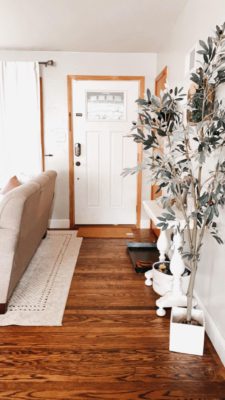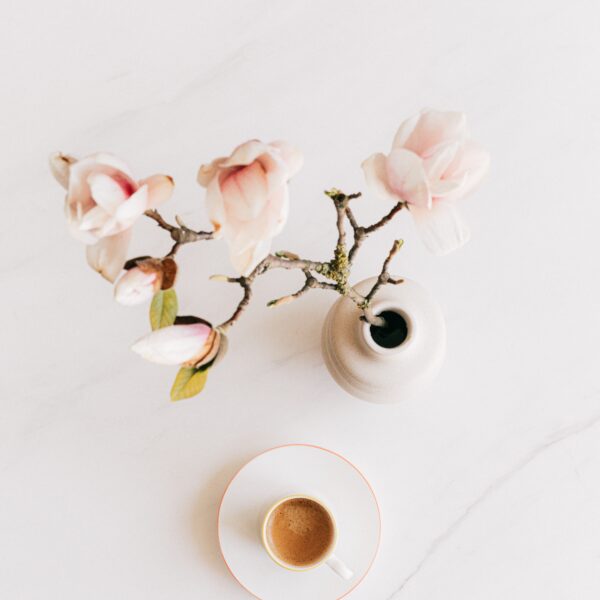Affiliate links are provided for your convenience, please read my disclosure for more information.
Have you ever walked into a room and wondered what is going on? It’s a hodge-podge of various trinkets, furniture, and accents in one place. None of the pieces match and all of the colors clash. Some of the room’s features are dated like lighting or wall treatments. It’s all one big eye sore. BUT…in today’s world, it can be easy to get sucked into the comparison game. Remember, it’s a journey of curating, designing, and decorating your home – not a race to match a showroom floor. Today, I’m sharing eight tips on how to create a cohesive look throughout your whole home so let’s get started!
8 Tips To Creating A Whole Home Cohesive Look
Tip #1: Define Your Overall Color Palette (And Stick To It)
This is personally my favorite place to start because I love color theory and color psychology. Color plays such a large part in creating holistic spaces that support an individual. I have a whole course, “Designing With A Neutral Color Palette” if you’re interested in diving in further about all of that. So, commonly, a whole color palette is made up of 6 colors – 1 dominant color, 4 accent colors, and 1 standard color. A dominant color normally is within your living spaces, lofts, and extra spaces. The four accent colors make up additional rooms, mostly bedrooms, and bathrooms. A standard color is the trim, wainscoting, and ceiling.
Tip #2: Choose A Design Style & Gather Pieces That Fit That Theme
I wrote a blog post here about this tip but to summarize, notice what you are drawn to. You may have more than one design style you like and that is okay! It is about learning about your style and the pieces that fit into that style. You may benefit from taking an online interior design quiz or reaching out to an interior designer to help you define your style.
Once you’ve done that, this is where the fun can begin. Make an account on Pinterest and make boards for each space within your home so you can start gathering inspiration all in one space!
Tip #3: Measure All Of Your Spaces
You’ve gathered your colors and your inspiration. Now it’s time to measure! Yes, you read that right. Many times, the #1 MISTAKE I hear my clients say is that I didn’t measure that so now the couch (bedframe, dining table, console table, television, etc.) doesn’t fit. I’ve even made this rookie mistake myself. It is costly. It is inefficient. As the pros will tell you, measure twice, cut once, or in this case, buy once.
One other tip, do NOT estimate either. Make sure you have exact measurements of your space before making any purchases. Also, if you decide to work with an interior designer, whether in-person or virtual, they will also ask for measurements ahead of your meeting date. Take the time to measure. Your future self will thank you.
Tip #4: Create A Design Concept For Each Space In The Home
You may hear from other bloggers, interior decorators, and even some interior designers call this a “mood board”. It is different. A Design Concept is significantly more in-depth. It typically takes the measurements of the space into account as well as design elements that may already exist within the space such as arches, popcorn ceilings, textured walls, and solutions for handling these elements. It takes into account the flooring already within the space as well or even if the flooring is wanting to be replaced. Other elements it takes into account are lighting like chandeliers, pendants, and side lamps; rugs to define spaces, cabinetry, etc.
Also, have fun making this because this is where you get to be creative! You can use my “Home Design Audit Guide” to help you compile all of it together.
Tip #5: Mix Old & New Pieces
I wrote a blog post about this tip here but to summarize, your home is always evolving and it should evolve with you. Some items will come and go while some pieces like storied decor and heirlooms will always have a place within your home. It is not about following rules or trying to achieve a particular look as fast as possible, but all about enjoying the slow approach of letting your spaces evolve as you do.
Also, not everything should match! You can use your old pieces as statements with modern furniture or vintage rugs with modern furniture. A gallery wall is a perfect place to mix old and new too. Have fun with it. Remember, it’s all about balance here.
Tip #6: Limit The Number & Size Of Fabrics & Patterns
There are many misconceptions that surround mixing and matching fabrics but that is definitely a story for another day so I promise to make this simple for you. It’s all about the rule of 3 here – 1 large dominant pattern and 2 smaller accent patterns. If you have an intricate pattern you want to carry across your living room or dining room, complement it with a simple pattern that can provide variation and contrast without taking away from the aesthetics.
Put simply, polka dots do not go with plaid. Florals do not go with ikat patterns. And animal prints only look good with other animal prints but I would caution you on this because too many are too many. In this case, less is more.
Tip #7: Add Greenery To Create A Cohesive Look
Greenery has been shown to be beneficial to our mental health, and the relaxation we feel when we look at plants makes us feel more at home. It also instantly livens up the space and adds color and texture. One major benefit of greenery is that it also can help purify the air we breathe. But if you have a black thumb like me, it is okay to have artificial plants as well. Try to bring in a few artificial (or real) plants of varying sizes but not so different types. I recommend doing your research about which ones you can take care of too. My personal favorite is the snake plant.
Tip #8: You Are Allowed To Change Your Mind
You may make a few returns on decor or furniture pieces. You may also decide to re-paint your walls a couple of times (in my case, 3) before deciding on the “right” color. I give you full permission to make mistakes, change your mind a gazillion times, and learn from them. It’s hard curating, designing, and decorating a home. It is a journey but it is so worth it. I hope that you decide to trust the process and enjoy the journey, even if you do change your mind about the other parts of it.
In Conclusion,
I hope all of these tips help. Honestly, I would ask that you remain true to yourself and your aesthetic. The beauty of a home lies in the story it tells about the people who live and make memories within it. Your house is your haven and I’d love to know how you’re doing on the journey. I’d love for you to leave me a comment below!
Love,






This is amazing! I find it interesting that you mentioned it’s a curating process and it’s ok to evolve. I’m in the process of updating my apartment, and I was struggling with the cohesiveness. I’ll implement these going forward. Thanks for sharing!